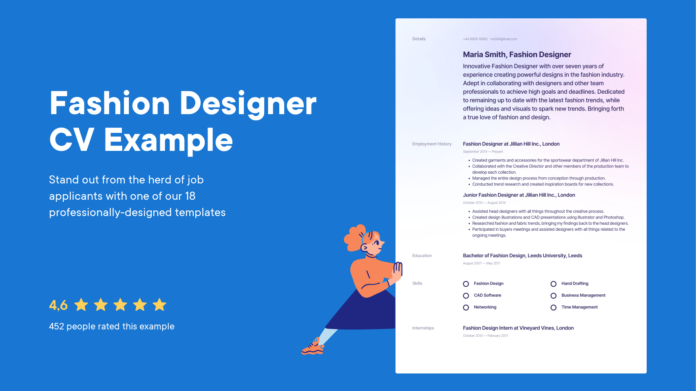It is not a secret that a well-crafted CV is your ticket to success. It’s your personal branding document showcasing your skills, experience, and passion for the industry. Whether you’re a seasoned stylist, a budding designer, or a fashion editor, a strong CV can open doors to exciting opportunities.
Table of Contents
Understanding the Fashion Industry
Before diving into CV writing, it’s crucial to understand the diverse landscape of the fashion industry. From high-end couture to streetwear, there are countless niches to explore. Each sector values different skills and experiences, so identifying your area of interest is essential. Whether you’re drawn to fashion design, styling, merchandising, marketing, or editorial work, your CV should reflect your unique path and passion in the fashion world.
Key Components of a Fashion Expert CV
A well-structured CV for a fashion expert typically includes the following sections:
Contact Information
Ensure your contact details are up-to-date and professional. This section should include:
- Your full name: Use the name you are most commonly known by in professional circles.
- Professional email address: Choose an email that is simple and uses your name or initials.
- Phone number: Include a number where you are easily reachable.
- LinkedIn profile (if applicable): A LinkedIn profile can provide additional professional context.
- Personal website or portfolio link: If you have a portfolio, make sure to include it. This allows employers to see your work firsthand.
Summary or Objective
This section is a concise statement highlighting your career goals, key skills, and unique selling points.
Example: “Experienced fashion stylist with a passion for sustainable fashion. Skilled in wardrobe styling, personal shopping, and trend forecasting. Seeking a challenging role in a dynamic fashion house.”
The objective should be tailored to each job application, aligning with the company’s values and the specific role.
Skills
Your skills section should be divided into hard and soft skills:
- Hard skills: These are technical abilities essential to the job, such as proficiency in design software (Adobe Photoshop, Illustrator), pattern making, garment construction, and knowledge of fashion terminology.
- Soft skills: These include interpersonal skills such as communication, creativity, problem-solving, attention to detail, and the ability to work under pressure.
This is an answer to how to make your CV stand out and a clear snapshot of your abilities.
Experience
Your experience section is where you detail your work history. Include relevant roles that showcase your expertise in the fashion industry.
- Quantify your achievements: Use metrics to demonstrate your impact. For example, “Increased sales by 20% through effective merchandising.”
- Highlight projects: Describe any notable projects or collaborations that showcase your skills. For instance, if you worked on a fashion show, detail your role and the outcome.
This section should demonstrate your growth and evolution in the industry, emphasizing the skills and experiences that make you a strong candidate for the role.
Education
In the fashion industry, education can play a significant role in your CV. This section should include:
Degrees, diplomas, or certifications: List any formal education related to fashion, design, or a relevant field.
Relevant coursework or workshops: If you’ve taken specialized courses or workshops, mention them, especially if they are directly related to the job you’re applying for.
Highlighting your education shows that you have a solid foundation in the principles of fashion and design.
Portfolio or Projects
A portfolio is a powerful tool in the fashion industry, providing a visual representation of your skills and creativity.
Include links or references: Make sure your CV includes links to your portfolio, website, or social media profiles where you showcase your work.
Highlight your best projects: Describe the process, challenges, and outcomes. Employers want to see not just the finished product but also how you approach your work and solve problems.
This section is particularly important for roles in design, styling, and marketing, where visual presentation is key.
Publications or Awards
If you’ve been published or received recognition, this section can add credibility to your CV.
List any articles, blog posts, or publications. Include contributions to fashion magazines, blogs, or other platforms.
Mention any awards or recognitions: If you have received any awards, list them along with a brief description of why you received them.
This demonstrates your thought leadership and influence within the fashion community.
Certifications and Licenses
Certifications can give you an edge in the competitive fashion industry.
List any relevant certifications or licenses: Include those from reputable institutions like the Fashion Institute of Technology or the Council of Fashion Designers of America.
These certifications show a commitment to ongoing learning and expertise in your field.
Tailoring Your CV for Different Roles
The specific content of your CV will vary depending on the role you’re applying for. Here are some tips for tailoring your CV to different fashion positions:
- Fashion Stylist: Emphasize your ability to create cohesive outfits, understand client preferences, and work with diverse budgets. Include any experience with personal shopping or wardrobe consulting.
- Fashion Designer: Highlight your design skills, knowledge of fabrics and materials, and ability to translate concepts into tangible garments. Showcase your creative process and any technical skills in pattern-making or garment construction.
- Fashion Editor: Showcase your writing skills, understanding of fashion trends, and ability to conduct interviews and research. Include any editorial pieces or fashion critiques you’ve written.
- Fashion Consultant: Emphasize your strategic thinking, business acumen, and ability to provide expert advice to clients. Detail any experience in market analysis or brand development.
- Fashion Merchandiser: Highlight your ability to plan and execute visual merchandising strategies, analyze sales data, and manage inventory. Include any experience with visual displays or retail layouts.
- Fashion Marketing: Showcase your understanding of fashion marketing trends, social media campaigns, and brand development. Detail any experience in content creation or influencer partnerships.
So, your journey in the fashion industry starts with a strong, compelling CV that sets you apart from the competition.

